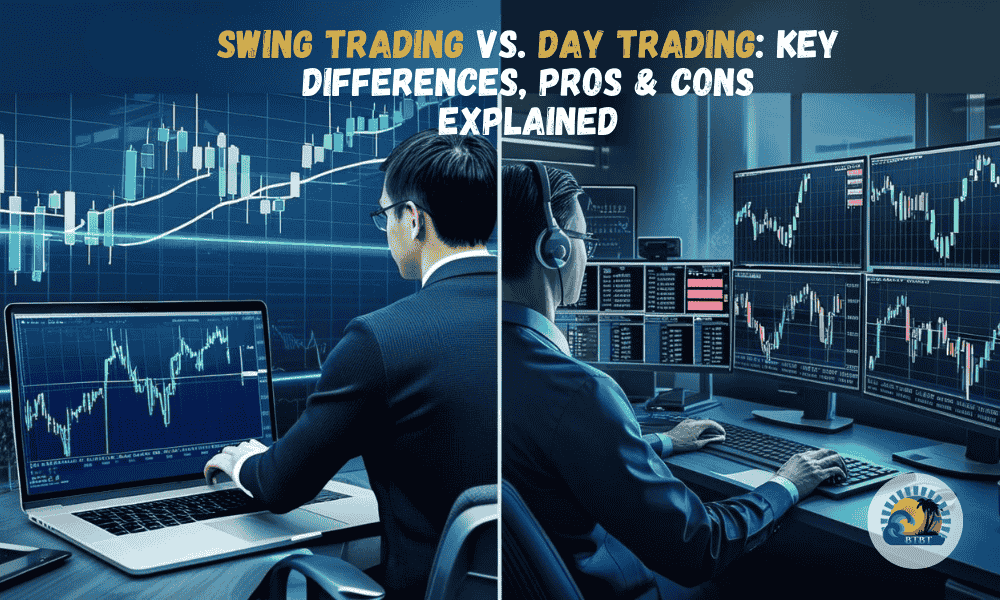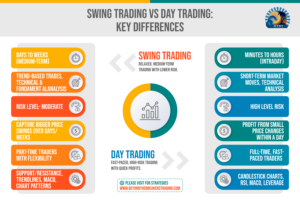
Swing Trading vs. Day Trading: Key Differences, Pros & Cons Explained
Introduction to Trading Styles
Making the right choice of trading style is one of the most important decisions a trader makes. Whether you are a beginner or trying to fine-tune your approach, knowing the basic differences between swing trading and day trading can help you strategize your plans, risk attitude, and lifestyle preferences.
Both swing trading as well as day trading have their unique pros and cons. While swing traders try to take advantage of the price movement over a period of days or weeks, which is a more accommodating approach for those who cannot look at the markets all the time, day trading requires the trader to perform many trades in a single session. Such trading needs high levels of focus and well-disciplined daily routines as it also involves very quick decision-making.
This guide will discuss the main differences, advantages, and disadvantages of each strategy to try to help you decide which style fits your trading persona best.
Key Features of Swing Trading
What is Swing Trading?
Swing trading is a trading style where positions are held for several days to a few weeks, aiming to capture medium-term price movements. Unlike day traders who focus on minute-to-minute price action, swing traders seek to profit from market swings—taking advantage of short-term trends, corrections, and breakouts.
Key Features of Swing Trading:
- Trade Duration: These can last anywhere from days or weeks, and in some cases longer depending on certain market conditions.
- Market Focus: Primarily active in trending and range-bound markets.
- Time Commitment: Less screen time is required compared to day trading, making it easier for part-time traders.
- Risk Exposure: Exposed to overnight and weekend risks such as earnings reports, geo-political occurrences, and macroeconomic shifts.
- Capital Requirements: Can be started with moderate capital but requires sufficient funds to withstand short-term volatility.
Common Swing Trading Strategies:
- Trend Following: Using moving averages or trendlines to enter trades that go with the direction of the trend.
- Breakout Trading: Entering trades when price breaks through key support or resistance levels.
- Retracement Trading: Buying during pullbacks in an uptrend or selling during rallies in a downtrend.
- Support & Resistance Trading: Based on price action signals, buy around support zones and sell around resistance zones.
Most of the time, swing traders will analyze the markets using technical analysis, but they can also confirm trade setups with earnings or other fundamental analysis.
Key Features of Day Trading
What is Day Trading?
Day trading involves executing buy and sell orders within a single day, keeping only intraday positions. Traders close their trades at the end of the day in order to minimize the risk of losses overnight. Day traders aim to profit from price changes by making multiple trades within a single session.
Key Features of Day Trading:
- Trade Duration: Day trading takes minutes or hours to conduct, but positions will always be closed at the close of the market.
- Market Focus: Focuses more on dynamic and liquid markets like stocks, forex, as well as commodities futures.
- Time Commitment: Scalping requires full-time commitment so it is less ideal for people with other responsibilities.
- Risk Exposure: There is significant risk because inventory volatility can be high, but there is no overnight exposure risk.
- Capital Requirements: Day trading requires higher capital due to the Pattern Day Trader (PDT) rule, which mandates that traders maintain at least $25,000 in their brokerage account for frequent trading in the USA.
Common Day Trading Strategies:
- Scalping: Capturing small price changes, traders set buy and sell at the same time or do finger trades simultaneously in rapid succession.
- Momentum Trading: Trade where the trader only considers entering a trade when there are keen price actions supported by vigorous volume.
- Range Trading: Buying a security at a support price in a betting market, and at a higher resistance price when selling.
- Breakout Trading: Get into an order above a certain price level with aggressive price action shift, traders can place an order when price shifts above the specified price mark.
Almost entirely, day traders depend on technical analysis employing various information tools like moving averages, relative strength index (RSI), MACD, as well as volume analysis. Short-term price shifts caused by news, earnings reports, and macroeconomic developments that happen need rapid reaction from traders too.

Key Differences Between Swing Trading and Day Trading
| Factor | Swing Trading | Day Trading |
| Timeframe | Days to weeks | Intraday (minutes to hours) |
| Trade Frequency | A few trades per week | Multiple trades per day |
| Risk Exposure | Overnight risk | No overnight risk |
| Capital Needed | Moderate | Higher due to PDT rule |
| Technical vs. Fundamental | Uses both | Primarily technical |
| Stress Level | Lower | High-pressure, fast-paced |
| Best Market Conditions | Trending or range-bound markets | High volatility, high liquidity |
Time Commitment: A day trader must spend the entire market session watching their screen, while swing traders only check a few times a day.
Risk and Volatility: Day trades internally can be volatile, but closing the position marks the end of the day, whereas swings risk gaps overnight.
Capital Requirements: Swing traders have the advantage of starting with a much smaller base than day traders, who need $25,000.
Psychological Demands: Having the ability to bear short-term loss and using decisiveness on a moment’s notice is far more rigorous than the patience required by swing trading.
Pros and Cons of Swing Trading
Pros of Swing Trading
✔ Less Time on the Screen – If you are a swing trader, you do not have to monitor your charts constantly like a day trader has to. If you have a full-time job, you can check your charts once every few hours.
✔ Opportunity for Greater Profits per Trade – Swing traders can hold their trades for several days or even weeks, allowing them to capture larger price movements relative to a day trader who exits his positions within the day.
✔ Less Stress on the Mind – All trading requires a certain amount of emotional discipline, however, swing trading is less psychologically demanding when compared to day trading.
✔ Acceptance of Different Market Conditions – Swing trading strategies can be used in both trending and non-trending markets which provides more clarity.
✔ Reduced Transaction Costs – Swing traders place fewer trades in a week compared to day traders, so commission and spread costs are significantly lower.
Cons of Swing Trading
✖ Risk of Gaps Over the Weekends and Overnight – Keeping positions open on market holidays makes traders susceptible to unpredicted news, earnings, political matters, and other events that cause gaps.
✖ Waiting is a Virtue – This is the opposite of day trading as it takes hours to close. Swing trading requires patience as it requires waiting for setups that may take longer to form.
✖ Higher Capital and Wider Stop Losses – Due to longer durations of holding onto trades, stop losses need to be wider, which further raises the requirement for a trader’s account balance to manage risk efficiently.
✖ Long-Term Moves Are Missed – The swing trader has to wait for a price to develop over days or even weeks, while a day trader is able to capitalize on instant intraday price changes.
Pros and Cons of Day Trading
Pros of Day Trading
✔ No Overnight Risk – All positions are closed before the market closes. This removes risks posed by overnight gaps.
✔ Multiple Trading Opportunities – Day traders are able to perform multiple trades per session and take advantage of short-term changes in prices.
✔ Fast Feedback on Strategy – With daily execution of trades, results of strategies can be seen quickly. Faster than with swing trading, they are able to adapt to their learned lessons.
✔ Potential for High Returns – Skillful day traders can use leverage and trades they make to increase their profits because of the high frequency of trades.
✔ Can Profit in Any Market Condition – As long as volatility is above a certain level, many movements in the market can be exploited; including periods of ranging and trending.
Cons of Day Trading
✖ High Time Commitment – Unpartable attention is required during trading hours, therefore not suited for people with other engagements.
✖ High Psychological Pressure – The fast-paced nature of day trading can increase stress levels, potentially leading to burnout or emotional decision-making.
✖ Higher Transaction Costs – With frequent changes in trades, the amount paid in spread and commissions increases, which can greatly affect profits.
✖ Requires Larger Capital in Stocks – For frequent trading due to the Pattern Day Trader (PDT) rule, US stock traders must have at least $25,000 in their account, which limits many users.
✖ It May Be Tougher For New Users – New traders will find it tougher to get into day trading as quick decisions accompanied by accurate execution are essential.
Which Trading Style is Right for You?
The selection between swing trading or day trading depends on several considerations such as how much time you can allocate to it, risk factors, funds, and a trader’s character.
- If you are someone who doesn’t have a lot of time on their hands and can manage moderate short-term losses, swing trading could be more suitable for you.
- If you enjoy being productive in a high-energy setting and can focus for long stretches of time, you may want to consider day trading.
- If you’re not quite sure, try simulating both strategies and see which one better suits you through paper trading.
Remember: Trading is not the same for everyone. To be successful, one must exercise self-control, manage risks, and learn constantly. For more trading related blogs, visit our blog page.
Final Thoughts
Swing trading and day trading have their own advantages and difficulties. Swing trading is less intensive and requires fewer trades, which can be easier for some. Day trading, although requiring intense focus, offers more opportunities in a day.
To decide what type of trading best fits you, you need to carefully analyze your preferences, how much risk you are willing to take, and how much time you have available. Regardless of the strategy you choose, becoming an expert in emotional discipline, risk management, and market analysis will put you in the best condition for long-term success.
Frequently Asked Questions:
-
What is the profit difference between swing trading and day trading?
Swing trading versus day trading profits depend on multiple factors like your personal risk level, market scenario, and finances. While day trading typically offers more profit opportunities because there may be multiple trades within a day, swing trading captures bigger price shifts over time, which in some cases, results in a higher profit per trade on a single swing trading trade than the day trading profit made in multiple trades.
-
Which is more profitable, swing trading or day trading?
Both styles of trading can yield profit when done well. Day trading does have multiple profit opportunities within a single day. However, it typically requires much more capital than some are willing to commit to. Alternatively, swing trades may provide higher profits in specific markets because they have a lower cost per trade and the price shifts that can be accessed throughout the trade duration are much larger throughout the days or weeks, unlike day trading.
-
What are the benefits of swing trading compared to day trading?
The most prominent benefits of swing trading include less time spent trading, fewer trades, and lower transaction costs. It also enables traders to profit from bull and bear markets which is much better than day trading where a trader has to watch the market at all times to maximize profits and the same must be done instantly without delay.







Very enlightening